2000 HONDA ODYSSEY fuel pressure
[x] Cancel search: fuel pressurePage 193 of 352
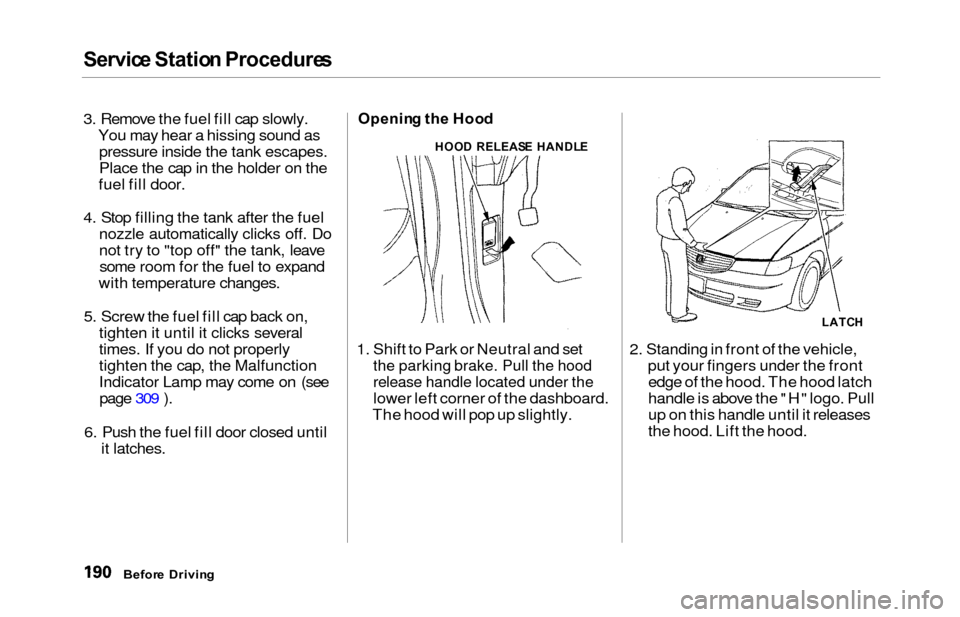
Service Statio n Procedure s
3. Remove the fuel fill cap slowly.
You may hear a hissing sound aspressure inside the tank escapes.
Place the cap in the holder on the
fuel fill door.
4. Stop filling the tank after the fuel nozzle automatically clicks off. Do
not try to "top off" the tank, leavesome room for the fuel to expand
with temperature changes.
5. Screw the fuel fill cap back on, tighten it until it clicks several
times. If you do not properly
tighten the cap, the Malfunction
Indicator Lamp may come on (seepage 309 ).
6. Push the fuel fill door closed until it latches.Openin g th e Hoo d
1. Shift to Park or Neutral and set
the parking brake. Pull the hood
release handle located under the
lower left corner of the dashboard.
The hood will pop up slightly. 2. Standing in front of the vehicle,
put your fingers under the frontedge of the hood. The hood latch
handle is above the "H" logo. Pull
up on this handle until it releases
the hood. Lift the hood.
Befor e Drivin g
HOOD RELEAS E HANDL E
LATCH
Page 197 of 352

Fuel Econom y
The condition of your vehicle and
your driving habits are the two most important things that affect the fuelmileage you get.
Vehicl e Conditio n
Always maintain your vehicle accord- ing to the maintenance schedule.
This will keep it in top operating
condition.
An important part of that mainte- nance is the Owne r Maintenanc e
Check s (see page 237 ). For
example, an underinflated tire
causes more "rolling resistance,"
which uses fuel. It also wears out faster, so check the tire pressure atleast monthly.
In winter, the build-up of snow on
your vehicle's underside adds weight and rolling resistance. Frequent
cleaning helps your fuel mileage and
reduces the chance of corrosion. Drivin
g Habit s
You can improve fuel economy by driving moderately. Rapid acceler-ation, abrupt cornering, and hard
braking use more fuel.
Always drive in the highest gear that allows the engine to run and acceler-
ate smoothly.
Depending on traffic conditions, try
to maintain a constant speed. Every
time you slow down and speed up,
your vehicle uses extra fuel. Use the cruise control, when appropriate, toincrease fuel economy. A cold engine uses more fuel than a
warm engine. It is not necessary to"warm-up" a cold engine by letting itidle for a long time. You can drive
away in about a minute, no matter
how cold it is outside. The engine
will warm up faster, and you get better fuel economy. To cut down on
the number of "cold starts," try to
combine several short trips into one.
The air conditioning puts an extra load on the engine which makes ituse more fuel. Turn off the A/C to
cut down on air conditioning use. Use the flow-through ventilation
when the outside air temperature is
moderate.
Befor e Drivin g
Page 240 of 352
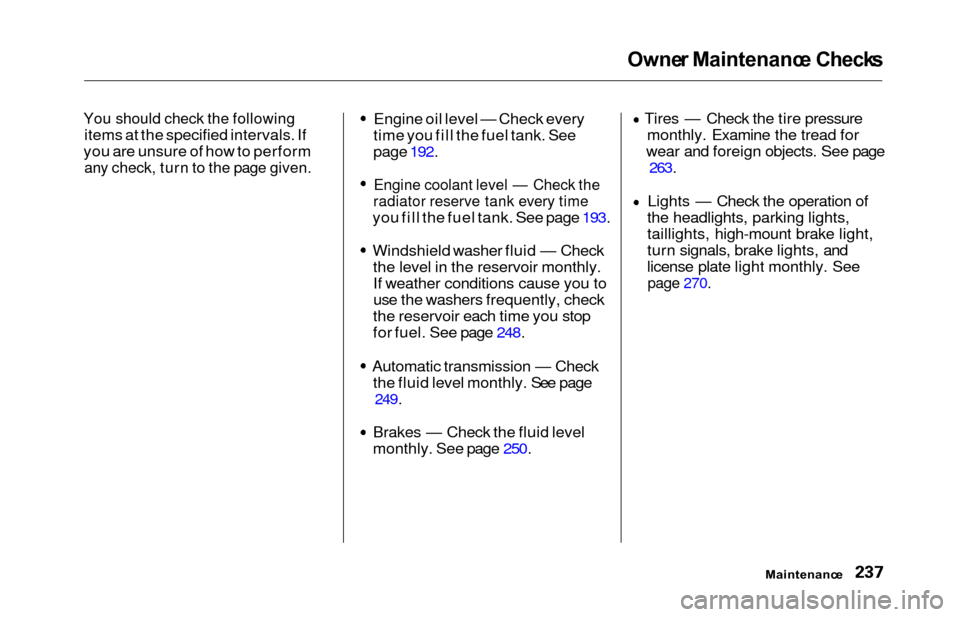
Owner Maintenanc e Check s
You should check the following
items at the specified intervals. If
you are unsure of how to perform
any check, turn to the page given.
Engine oil level — Check every
time you fill the fuel tank. See
page 192.
Engine coolant level — Check the
radiator reserve tank every time
you fill the fuel tank. See page 193.
Windshield washer fluid — Check the level in the reservoir monthly.If weather conditions cause you to
use the washers frequently, check
the reservoir each time you stop
for fuel. See page 248.
Automatic transmission — Check the fluid level monthly. See page
249.
Brakes — Check the fluid level
monthly. See page 250. Tires — Check the tire pressure
monthly. Examine the tread for
wear and foreign objects. See page
263.
Lights — Check the operation of
the headlights, parking lights,
taillights, high-mount brake light,
turn signals, brake lights, and
license plate light monthly. See
page 270.
Maintenanc e
Page 266 of 352
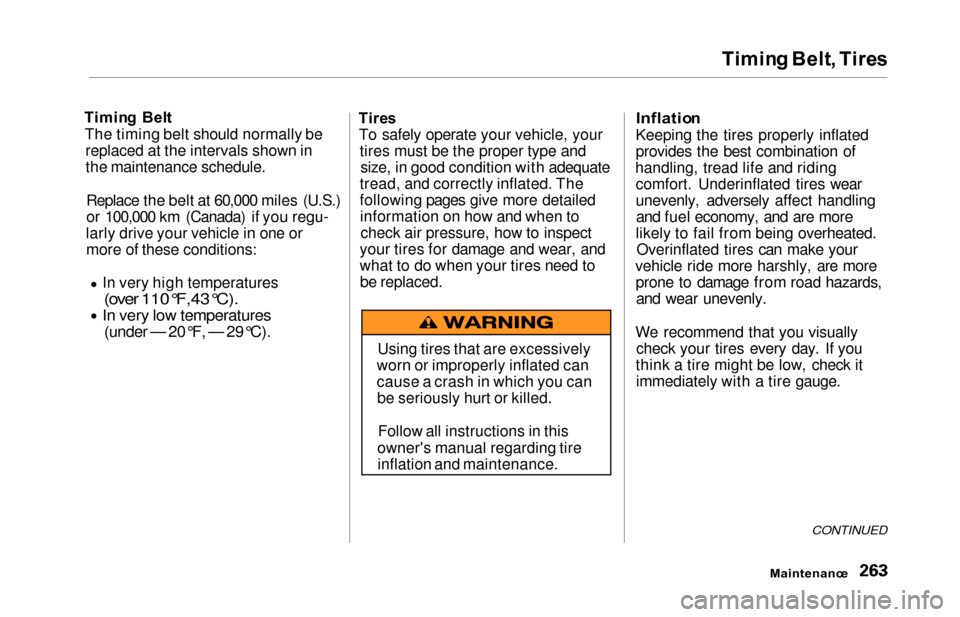
Timing Belt , Tire s
Timin g Bel t
The timing belt should normally be replaced at the intervals shown in
the maintenance schedule.
Replace the belt at 60,000 miles (U.S.)
or 100,000 km (Canada) if you regu-
larly drive your vehicle in one or more of these conditions:
In very high temperatures
(over 110°F,43°C).
In very low temperatures
(under — 20°F, — 29°C).
Tire s
To safely operate your vehicle, your tires must be the proper type andsize, in good condition with adequate
tread, and correctly inflated. The
following pages give more detailed information on how and when tocheck air pressure, how to inspect
your tires for damage and wear, and
what to do when your tires need to be replaced.Inflatio n
Keeping the tires properly inflated
provides the best combination of
handling, tread life and riding comfort. Underinflated tires wear
unevenly, adversely affect handlingand fuel economy, and are more
likely to fail from being overheated. Overinflated tires can make your
vehicle ride more harshly, are more prone to damage from road hazards,and wear unevenly.
We recommend that you visually check your tires every day. If you
think a tire might be low, check it immediately with a tire gauge.
CONTINUED
Maintenanc e
Using tires that are excessively
worn or improperly inflated can
cause a crash in which you can be seriously hurt or killed.
Follow all instructions in this
owner's manual regarding tire inflation and maintenance.
Page 345 of 352
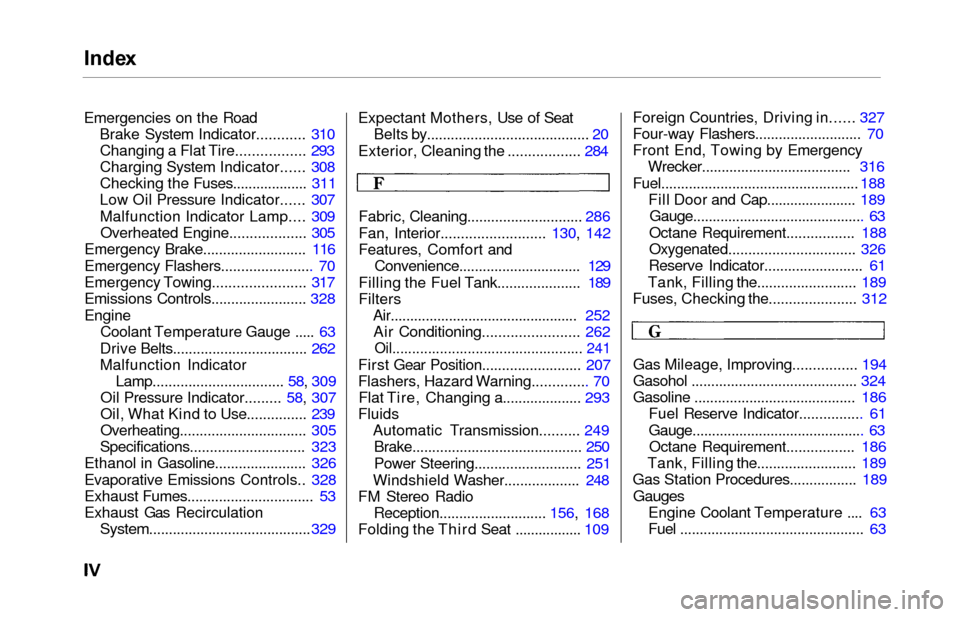
Index
Emergencies on the Road
Brake System Indicator............ 310Changing a Flat Tire................. 293
Charging System Indicator...... 308
Checking the Fuses................... 311
Low Oil Pressure Indicator...... 307
Malfunction Indicator Lamp.... 309Overheated Engine................... 305
Emergency Brake.......................... 116
Emergency Flashers....................... 70
Emergency Towing....................... 317
Emissions Controls........................ 328
Engine Coolant Temperature Gauge ..... 63
Drive Belts.................................. 262
Malfunction Indicator Lamp................................. 58, 309
Oil Pressure Indicator......... 58, 307
Oil, What Kind to Use............... 239
Overheating................................ 305
Specifications............................. 323
Ethanol in Gasoline....................... 326
Evaporative Emissions Controls.. 328
Exhaust Fumes............................... . 53
Exhaust Gas Recirculation
System......................................... 329
Expectant Mothers, Use of Seat
Belts by......................................... 20
Exterior, Cleaning the .................. 284
Fabric, Cleaning............................. 286
Fan, Interior.......................... 130, 142
Features, Comfort and Convenience............................... 129
Filling the Fuel Tank..................... 189
Filters Air............................................... . 252
Air Conditioning........................ 262
Oil................................................ 241
First Gear Position......................... 207
Flashers, Hazard Warning.............. 70
Flat Tire, Changing a.................... 293
Fluids Automatic Transmission.......... 249Brake........................................... 250
Power Steering.......................... . 251
Windshield Washer................... 248
FM Stereo Radio Reception........................... 156, 168
Folding the Third Seat ................. 109 Foreign Countries, Driving in......
327
Four-way Flashers........................... 70
Front End, Towing by Emergency Wrecker...................................... 316
Fuel.................................................. 188
Fill Door and Cap....................... 189
Gauge............................................ 63
Octane Requirement................. 188
Oxygenated................................ 326
Reserve Indicator........................ . 61
Tank, Filling the......................... 189
Fuses, Checking the...................... 312
Gas Mileage, Improving................ 194
Gasohol .......................................... 324
Gasoline ......................................... 186 Fuel Reserve Indicator................ 61
Gauge............................................ 63
Octane Requirement................. 186
Tank, Filling the......................... 189
Gas Station Procedures................. 189
Gauges
Engine Coolant Temperature .... 63
Fuel
.............................................. . 63
Page 347 of 352
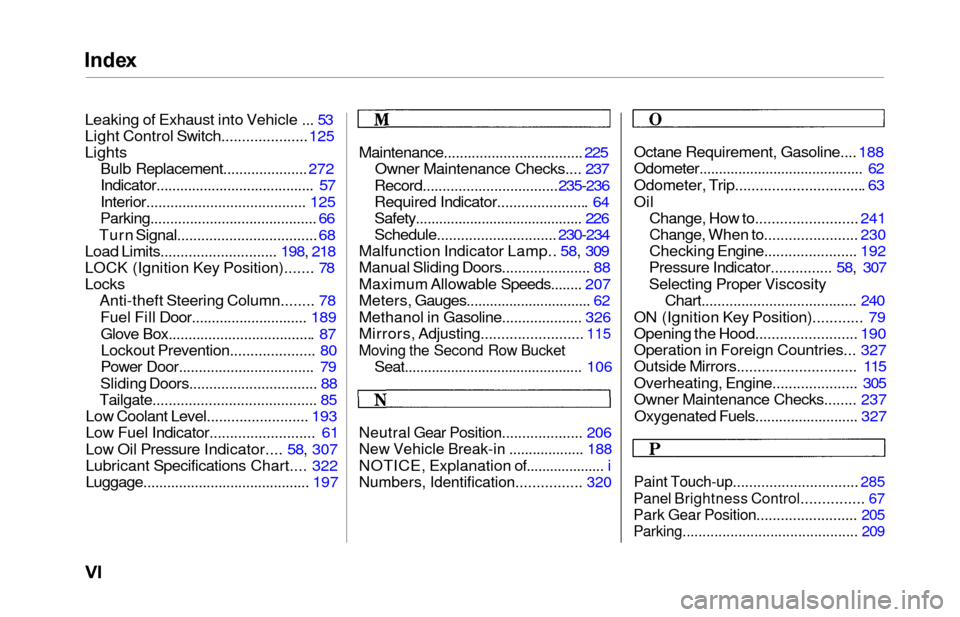
Index
Leaking of Exhaust into Vehicle ... 53
Light Control Switch..................... 125
Lights Bulb Replacement..................... 272
Indicator........................................ 57
Interior........................................ 125
Parking.......................................... 66
Turn Signal................................... 68
Load Limits............................. 198, 218
LOCK (Ignition Key Position)....... 7 8
Locks Anti-theft Steering Column........ 78
Fuel Fill Door............................ . 189
Glove Box.................................... . 87
Lockout Prevention..................... 80
Power Door.................................. 79
Sliding Doors................................ 88
Tailgate......................................... 85
Low Coolant Level......................... 193
Low Fuel Indicator.......................... 61
Low Oil Pressure Indicator.... 58, 307
Lubricant Specifications Chart.... 322
Luggage.......................................... 197 Maintenance...................................
225
Owner Maintenance Checks.... 237
Record.................................. 235-236
Required Indicator...................... . 64
Safety.......................................... . 226
Schedule.............................. 230-234
Malfunction Indicator Lamp.. 58, 309
Manual Sliding Doors...................... 88
Maximum Allowable Speeds........ 207
Meters, Gauges................................ 62
Methanol in Gasoline.................... 326
Mirrors, Adjusting.........................
115
Moving the Second Row Bucket
Seat.............................................. 106
Neutral Gear Position.................... 206
New Vehicle Break-in ................... 188
NOTICE, Explanation of.................... i
Numbers, Identification................ 320
Octane Requirement, Gasoline.... 188
Odometer.......................................... 62
Odometer, Trip............................... . 63
Oil
Change, How to......................... 241
Change, When to....................... 230
Checking Engine....................... 192
Pressure Indicator............... 58, 307
Selecting Proper Viscosity Chart....................................... 240
ON (Ignition Key Position)............ 79
Opening the Hood......................... 190
Operation in Foreign Countries... 327
Outside Mirrors............................ . 115
Overheating, Engine..................... 305
Owner Maintenance Checks........ 237
Oxygenated Fuels.......................... 327
Paint Touch-up.............................. . 285
Panel Brightness Control............... 67
Park Gear Position......................... 205
Parking............................................ 209
Page 350 of 352

Index
Tachometer...................................... 62
Tailgate............................................. 85
Opening the.................................. 85
Open Monitor Light.................... 60
Taillights, Changing Bulbs in....... 275
Taking Care of the Unexpected .. 291
Tape Player ........................... 160, 181
Technical Descriptions DOT Tire Quality Grading....... 324
Driving in Foreign Countries... 327
Emissions Control Systems...... 328Oxygenated Fuels...................... 326
Three Way Catalytic Converter................................ 330
Temperature Gauge........................ 63 Tensioners, Seat Belts.................... 50Tether Attachment Points.............. 43
Theft Protection............................ .
186
Three Way Catalytic Converter... 330
Time, Setting the........................... 117
Timing Belt..................................... 263
Tire Chains..................................... 269
Tire, How to Change a Flat.......... 293 Tires...............................................
. 263
Air Pressure.............................. . 263
Balancing.................................... 266
Checking Wear.......................... 265
Compact Spare........................... 292
DOT Tire Quality Grading....... 324
Inflation....................................... 263
Inspection................................... 265 Replacing.................................... 267
Rotating....................................... 266
Snow........................................... . 269
Specifications............................ . 323
Tire Chains................................. 269
Towing
A Trailer ................................. 218
Emergency Wrecker................. 317
Traction Control System (TCS)... 213
Transmission
Checking Fluid Level................ 249
Fluid Selection........................... . 249
Identification Number............... 321
Shifting the Automatic.............. 205
Treadwear...................................... 324
Trip Meter......................................... 63
Turn Signals..................................... 68
Tools, Tire Changing ................... 293
Underside, Cleaning...................... 288
Unexpected, Taking Care
of the .......................................... 29 1
Uniform Tire Quality Grading .... 324
Unleaded Gasoline......................... 188
Upholstery Cleaning...................... 286
Used Oil, How to Dispose of........ 242
Vanity Mirror................................. 121
Vehicle Capacity Load.......... 198, 218
Vehicle Dimensions....................... 322
Vehicle Identification Number..... 320
Vehicle Storage.............................. 281
Ventilation............................. 133, 138
VIN ................................................. 320
Vinyl Cleaning ............................... 286
Viscosity, Oil.................................. . 240
CONTINUED